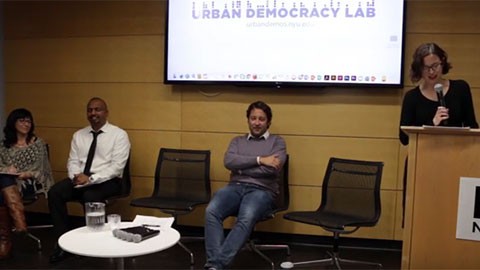NYU Gallatin student Rachel Stern reviews the event, “The Politics of Documenting Neighborhood Change,” hosted by the Urban Democracy Lab on October 25, 2016.
The Politics of Documenting Neighborhood Change was a panel discussion of how ethnography and oral histories can be used to study and paint a picture of the complex relationships that people have in their neighborhoods, especially neighborhoods undergoing gentrification, or changes in ethnic or social configurations. The audience was packed, with people sitting on the floor next to the stage and squeezed together on the seats. The panel talk proposed important questions about the successes and failures of ethnography and oral histories for documenting neighborhood change, how documentation can affect the futures of those neighborhoods, and how we can conceptualize the politics of that documentation.
The panel included: Zaheer Ali, an oral historian at the Brooklyn Historical Society, who works to document the lived testimonies of Brooklyn’s people and cultural identity, including digitizing oral history; Heather Dalmage, Professor of Sociology and the Director of the Mansfield Institute for Social Justice at Roosevelt University; Max Holleran, a Ph.D Candidate in Sociology at NYU who has studied post-socialist architectures; and Becky Amato, the associate director of the Urban Democracy Lab, and a historian and professor who has done work on neighborhood change in Brooklyn. Jack Tchen, who is the Director of the American Pacific Studies (APA) Institute at NYU and a professor at Gallatin, moderated.
Max Holleran kicked things off by talking about what urban ethnography tries to do, how it does that, and whether it does that well or not. Defining ethnography in layman’s terms as “deep hanging out,” Holleran continued on to focus on foundational texts in ethnography and possible downsides to applying them to various situations. He began by bringing up the Park and Burgess model made in the early 1920s, a map of early zoning. This map shows that neighborhoods were originally seen as static things that didn’t change much and the model only allowed fluctuation of people in and out of the neighborhood, not actual neighborhood change. In particular, Holleran focused on two problematic elements of ethnography: the use of neighborhood groups by ethnographers only as points of access, and the problem with ethnography not being good at predictive outcomes because it only expresses one person’s point of view. This part of the panel gave a good foundation for the rest of the speakers, and raised some key issues with the methodology of ethnography. What are the ethical concerns around involving oneself in a community for the purpose of research and leaving when it is over? How does this affect neighborhood change and the sense of overturn in a neighborhood that is already experiencing it?Heather Dalmage, who has most recently published a book called Vanishing Eden: White Construction of Memory, Meaning, and Identity in a Racially Changing City, spoke about her experiences writing the book and what the process of interviewing and gathering oral histories revealed for her in her work. In writing this book, she did research on the South and Southwest sides of Chicago, in particular on the neighborhood of Marquette Park. Her work was inspired by a photograph in the Chicago Tribune that depicted Dr. Martin Luther King Jr. and a white man shielding Dr. King from white people standing on the side with their children. These white people, Dalmage recounted, had angry faces, and it struck her that these people loved each other within their community, but were teaching their children how to hate. Her work stemmed from the need to understand how these children grew up after being taught how to hate, especially as neighborhoods became desegregated. How did these children make sense of the hatred they were taught and how does that shape their racial perspectives? How are they going to make sense of their ideas in a color-blind era when they had viewed and grown up viewing race so explicitly?
Dalmage and her co-author Mike Malley faced ethical questions when they were conducting their research. In particular, they needed to use a snowball sample approach, and in order for that to work, they had to build trust with the participants in order to interview them. There were also gender issues, so Malley had to interview the men and Dalmage had to interview the women. In interacting with the participants, they had to figure out how to deal with the plainly racist views that they were faced with and how to interact with those statements to least interfere with the interview they were conducting. What they settled on was a method of “nodding passing,” which indicates to the speaker, “Keep talking, I’m listening.” Considering how one might gather oral histories and information in the face of extreme racism from the interviewee is very important, as the way in which one chooses to interact can have effects on the outcome of the research. This aspect of research may be underexamined, so Dalmage’s approach to the issue is much valued.
Dalmage found that a reliance on two main facets of thought functioned to maintain goodness/moral upstanding in the community while at the same time perpetuating racism: (1) the idea of nostalgia, and (2) the idea of “bounded empathy.” Nostalgia works as a vehicle for understanding how neighborhoods have been changed by “blackness” with phrases used such as “when we were kids” and the key phrase “until,” which is followed by “the first black family moved in” or “these other people moved in.” Nostalgia falls in line with the idea that these “idyllic” communities have been “destroyed by blackness” and promotes racism in these communities. The researchers found the idea of “bounded empathy” as equally important in keeping racism alive. This phrase refers to understanding and making excuses for the ways parents and grandparents thought and acted — the idea that “we have exposure because we made it to college but our parents didn’t and that’s why they acted how they acted,” the idea that parents’ and grandparents’ racist views are acceptable. This allows whiteness to expand to cover white supremacy while these white people maintain the thought of themselves as good. Dalmage’s presentation raised intriguing questions of how one conducts ethnographic research in the face of racism, the ways in which oral histories can function to reveal ideas that structure a community, and how this type of research can have effects on the researchers.
Zaheer Ali, an oral historian at the Brooklyn Historical Society, spoke next about his project, “Listening to the Voices of Crown Heights: Using Oral Histories to (Re)Claim Spaces.” Crown Heights, he explained, is an interesting place to consider how oral histories can work and illuminate the processes of gentrification and neighborhood change. Crown Heights is one of the fastest gentrifying neighborhoods and is known in the public sense for the Crown Heights Riot that occurred on August 21, 1991 and unleashed growing tensions between the Afro-Caribbean and the Hasidic Jewish community. Ali’s work focuses particularly on how the riot figures in the history of the neighborhood, where integration is viewed as marking the beginning of the history of Crown Heights, a figurative ground zero in gentrification narratives where recovery started happening. Therefore, gentrification is painted as something we should celebrate because it comes to represent that the neighborhood has finally overcome violence and intolerance, and gentrification becomes inextricably linked in the public view with the idea of reconciliation. This sketch is a very short and limited picture of the rich history of Crown Heights and Ali is concerned with developing longer histories, where oral histories are invaluable.
Another important element of oral histories that Ali pointed out is the attempt by real estate developers and other vehicles of gentrification to market history as they sell those neighborhoods. Specifically, this can be seen in an interview on the neighborhood of Fort Greene in the New York Times on October 20, 2015 (http://www.nytimes.com/2015/10/20/realestate/block-by-block-fort-greene.html), where the rich history of the neighborhood is used to market it and make it seem desirable to a new group of people. This brings up the interesting question of what the relationship should be between historians and historical societies, and marketers and business ventures that capitalize on history to make a profit. In a growing market for such “rich history” and an increased focus on selling a neighborhood, we must amplify the voices of the people who live there for the sake of documenting the neighborhood, rather than this marketing approach.
The Brooklyn Historical Society’s oral history project on Crown Heights is designed around the idea of listening. In the words of Dr. Martin Luther King Jr., “a riot is the language of the unheard.” The project is not about giving a voice to the voiceless because these people are not voiceless, but rather giving ears to the earless, who have not learned to listen. In this project, BHS has partnered with Weeksville Heritage Center and Brooklyn Movement Center, which work to bring histories of resistance that decenter the “riot” and challenge gentrification narratives to the forefront. They also work to counter the hegemonic mapping of working and living spaces, and amplify overlooked voices and labor of community residents, activists and institutions.
Becky Amato’s project, “Displaced Urban Histories: Documenting Gentrification on the Southside of Williamsburg,” built on this idea of community partnership and how that can be used as a documentation for neighborhood change. It is based around an interdisciplinary seminar that she has taught at NYU Gallatin for the past few years where students partner with residents through Los Sures (Southside United HDFC), which is a community organization that serves the Latino community of Williamsburg’s South Side and works to promote affordable housing, tenant advocacy, and cultural elements of the community.
One of the goals of the project is to historicize the process of gentrification and counter the idea that gentrification is ahistorical. Gathering oral histories is essential to this process, as students gather life histories from residents and archive things from their lives, amplifying their voices and giving details of their lives new meaning and importance. The project is invaluable to the students who learn about the big picture, but the process of gathering life histories and archiving parts of residents’ lives gives new meaning to the destruction that gentrification can cause and the necessary documentation of this neighborhood change.
The panel ended with questions, open-ended and ready for discussion. Whose stories did we really tell, and for what purpose? How might different audiences engage with this material and what does this mean for our process of engagement as researchers, historians, and audience members? What are the ethical implications of connecting historical research and political activism? Conversations like these are the base of considering the political, ethical, racial and social implications of research in neighborhoods that are undergoing significant change, and how historians should relate to that change and talk about it. Especially in our current political climate, should history be linked to political activism and political views? What are the dangers of depoliticizing histories or strongly politicizing them? What is the way forward?

